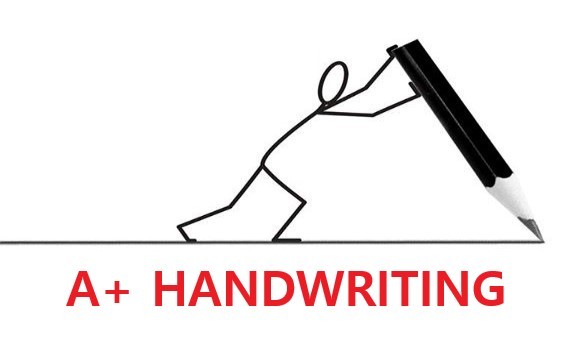Executive Skills for Handwriting
EXECUTIVE SKILLS
Needed for HANDWRITING

Handwriting is a fundamental skill that plays a vital role in a child’s academic and personal development. However, the process of writing involves much more than just fine motor skills and forming letters on paper. It requires a complex set of cognitive abilities known as Executive Function skills. These skills are responsible for organizing thoughts, planning actions, and executing tasks effectively. In this article, we will explore the executive function skills required for handwriting, discuss the importance of occupational therapy interventions, highlight the goal of automaticity in handwriting, and present a brief review of supporting research.
EXECUTIVE FUNCTION SKILLS FOR HANDWRITING –
WORKING MEMORY – Working memory refers to the ability to hold and manipulate information in mind over short periods of time. When it comes to handwriting, working memory plays a crucial role in remembering letter formations, spelling rules, and punctuation. It allows individuals to recall and apply this knowledge while writing, ensuring that each letter is formed correctly and in the appropriate sequence for writing fluency. Strategies such as repeating letter formations, visualizing letter shapes, and using mnemonic devices can enhance working memory and facilitate efficient handwriting.
ATTENTION CONTROL – Attention control refers to the ability to focus and sustain attention on a specific task while filtering out distractions. For successful handwriting, individuals need to maintain their attention on the writing task, allowing them to concentrate on letter formation, spacing, and alignment. Adequate attention control helps minimize errors and inconsistencies, resulting in neat and legible handwriting. Occupational therapy interventions focus on improving attention control, enabling individuals to sustain their focus on the writing task. Techniques like sensory strategies, environmental modifications, and self-regulation techniques can help individuals filter out distractions and maintain attention while writing. Improved attention control promotes accuracy and legibility in handwriting.
INHIBITION – Inhibition is the ability to suppress impulsive or irrelevant responses. In the context of handwriting, inhibition is crucial for maintaining appropriate writing speed and pressure. It enables individuals to control the force applied to the pen, preventing excessive pressure that can lead to smudged or illegible writing. Through various techniques, such as adjusting pen grip, using weighted utensils, or incorporating finger strengthening exercises, individuals can gain better control over their fine motor movements. This helps prevent excessive pressure and allows for smoother, more controlled handwriting.
The executive skill of Inhibition also helps individuals refrain from distractions or impulsive movements that may take their attention away and interfere with the writing process. Moreover, the skills of inhibition are developed over time through the process of learning and applying emotional self-regulation strategies. One method used in my OT practice to improve students’ focus and resilience for attention to handwriting and better emotional regulation is the Safe and Sound Protocol.
PLANNING AND ORGANIZATION – Planning and organization skills involve breaking down a task into smaller, manageable steps and sequencing them effectively. When it comes to handwriting, planning and organization are vital for pre-writing activities, such as gathering materials, positioning the paper, and choosing the right writing tool. Additionally, these skills contribute to organizing thoughts and structuring sentences while writing, resulting in coherent and well-structured age-appropriate compositions.
Occupational therapy interventions address planning and organization skills to improve pre-writing activities and the writing process itself. Our OTs may provide visual cues, graphic organizers, or step-by-step instructions to help individuals break down tasks and sequence them effectively. These strategies enhance planning and organization abilities, leading to more structured and coherent written work.
COGNITIVE FLEXIBILITY – Cognitive flexibility refers to the ability to adapt to new or changing situations and switch between different tasks or perspectives. In the context of handwriting, cognitive flexibility enables individuals to adjust their writing style based on the requirements of the writing assignment. This skill allows individuals to switch between print and cursive writing, modify letter size and spacing, or adjust their writing speed as needed.
Our OT interventions focus on developing cognitive flexibility to adapt writing styles based on context and assignment requirements. By practicing different writing formats, such as print and cursive, and exploring creative writing exercises, individuals can enhance their cognitive flexibility. This executive skill allows for versatility in handwriting and facilitates adaptability to different writing tasks.
SELF MONITORING AND FEEDBACK – Self-monitoring involves the ability to reflect on one’s performance and identify errors or areas for improvement. Effective self-monitoring is crucial for handwriting, as it helps individuals identify and correct mistakes, such as letter reversals, inconsistencies in letter formation, or improper spacing. Regular self-feedback and reflection contribute to continuous improvement and the development of efficient handwriting skills.
Evidence-based OT interventions promote self-monitoring and provide feedback to enhance handwriting skills. OTs at A+ Handwriting encourage individuals to reflect on their writing, identify errors, and develop strategies for self-correction. Through guided practice and constructive feedback, individuals become more aware of their writing patterns and can make adjustments for improved legibility and automaticity.
Handwriting Automaticity refers to the ability to write effortlessly and fluently without conscious effort. When handwriting becomes automatic, individuals can focus more on the content of their writing rather than the mechanics. Research shows that achieving automaticity in handwriting requires consistent practice, reinforcement of proper techniques, and gradual reduction of reliance on explicit executive function skills. With automaticity, individuals can write efficiently, allowing ideas to flow seamlessly onto paper.
In summary, handwriting proficiency relies on the integration of executive function skills, emotional regulation, sensory integration integrity, as well as basic fine motor, and cognitive abilities. Occupational therapy interventions play a significant role in promoting the development of all these underlying skills to support handwriting proficiency. By addressing the executive skills of working memory, attention control, inhibition, planning and organization, cognitive flexibility, and self-monitoring, we help students achieve automaticity in handwriting. With enhanced executive function skills and the goal of automaticity, individuals can express their thoughts and ideas effectively through legible, fluent, and confident handwriting. By understanding the importance of these executive function skills in handwriting, educators, parents, and individuals themselves can provide targeted support and interventions to develop and enhance these abilities, fostering success and confidence in written communication.
Research Supporting Evidence-Based OT Interventions –
Occupational therapy interventions for improving executive function skills related to handwriting have been supported by research. Here are some key studies that highlight the effectiveness of evidence-based OT interventions:
Case-Smith, J., & DeLuca, S. (2014):
A systematic review conducted by Case-Smith and DeLuca examined the effectiveness of interventions targeting handwriting skills in children with and without disabilities. The review found strong evidence supporting the use of occupational therapy interventions, including sensory integration and perceptual-motor interventions, to improve handwriting legibility and speed in children with various conditions.
Feder, K. P., Majnemer, A., Synnes, A., & Hanlon-Dearman, A. (2000):
In a study conducted by Feder et al., the effects of an occupational therapy handwriting intervention were examined in preterm children. The intervention targeted fine motor skills, visual-motor integration, and handwriting techniques. The results showed significant improvements in handwriting legibility and speed, highlighting the effectiveness of occupational therapy interventions for preterm children.
Schwellnus, H., Carnahan, H., Kushki, A., Polatajko, H., & Missiuna, C. (2012):
A study by Schwellnus et al. explored the effects of an executive function intervention, Cognitive Orientation to Occupational Performance (CO-OP), on handwriting skills in children with developmental coordination disorder (DCD). The CO-OP approach focuses on goal-directed problem-solving and cognitive strategy use. The findings demonstrated significant improvements in handwriting performance and overall functional skills in children with DCD.
Pfeiffer, B., Henry, A. L., Miller, A. C., & Ziviani, J. (2014):
Pfeiffer et al. conducted a randomized controlled trial to investigate the effects of an intervention targeting self-regulation and handwriting skills in children with autism spectrum disorder (ASD). The intervention incorporated self-regulation strategies, including visual supports and self-monitoring techniques. The results revealed significant improvements in handwriting legibility and self-regulation skills, suggesting the effectiveness of occupational therapy interventions for children with ASD.
Zwicker, J. G., Harris, S. R., & Klassen, A. F. (2012):
A systematic review conducted by Zwicker et al. examined the effectiveness of interventions targeting handwriting skills in children with developmental coordination disorder (DCD). The review included various interventions, such as sensory integration, perceptual-motor, and cognitive-based interventions. The findings demonstrated moderate evidence supporting the effectiveness of occupational therapy interventions for improving handwriting skills in children with DCD.
In conclusion, the effectiveness of occupational therapy interventions for improving executive function skills related to handwriting is supported by research evidence. Studies have demonstrated the positive impact of interventions targeting sensory integration, perceptual-motor skills, cognitive strategies, and self-regulation techniques. Whether working with children with specific conditions or those without disabilities, evidence-based OT interventions have shown significant improvements in handwriting legibility, speed, and overall functional skills. These findings emphasize the value of occupational therapy in enhancing executive function skills necessary for successful handwriting.
